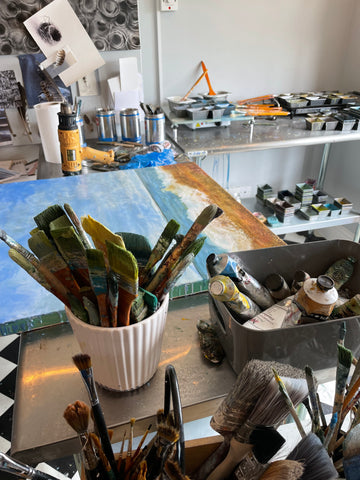News — Norfolk
The Agony and the Ecstasy of Oil Painting
The Agony and the Ecstasy of Oil Painting
Jac Scott
A friend recently asked me if I ever get bored painting the coast? My reply came easily - the coastline is always changing, in every second it metamorphoses. Aiming and failing to capture that energy or tranquility is so bewitching that I'll never master it or tire of trying to do so.
Painting the Norfolk Coast
The elements of sky, sea and shore dance and shift continually. It's the movement and the interplay of the elements that is beguiling. Standing before the ocean and absorbing the sights, sounds and smells to carry home to the studio, is both humbling and invigorating. I find making short videos of the panorama can help the journey, but nothing matches the initial excitement of the moment. Doing quick sketches and colour studies are an intrinsic part of the process. The large scale I prefer to work at demands a big set up, so it is highly problematic working on location.

Painting Simple Compositions with Complicated Layers
The compositions are rudimentary - I really like that. Capturing the viewer's eye without an obvious focal point demands other elements of interest and nuance. Colour and texture are key. The process is dynamic. It makes it even more challenging to carry that simplicity and create a picture that has depth, movement and spirit. The techniques I use embraces this - nurturing the notion of shifting layers. Visualising and then building the layers is a multi-pronged operation where understanding three-dimensions is critical. One is building from the back of the painting and seeing forward - therefore planning is key.
Each element is faceted like colours - their translucency or opaqueness is important to exploit the medium's variables. Subject matter such as skies and seas envelop the multi-layered approach and react well to embracing different strengths of coloured layers.

Emotional Painting
Yes the paintings are emotional expressions, not copies of anything stagnant. I want them to be transitional - to carry one to another place - to form a ticket to ride. Painting requires concentration and control, and yet however much you master the materials, there is always an element of serendipity that I love. That unexpected joy or horror that emerges when you think it's safe. This duality of agony and ecstasy whilst painting becomes a canvas full of problems to solve and I am elated if I manage to master them. Such an absorbing activity is demanding both mentally and physically, especially when I work on the big panels. The width and longevity of my art practice definitely informs my painting. It has nuances towards sculpture - planning in three dimensions, layering and cutting back.

Moving to North Norfolk
I grew up by the sea and regularly spent hours watching the waves, never thinking that those early memories would guide my focus now. When we moved from Bournemouth to the Lake District I was still needing to regularly visit the coast and share the big skies away from the brooding mountains. Moving to North Norfolk was liberating - it is a special place: a sanctuary and a stimulus for my spirit and my art practice. We had visited for seven years before we decided to move permanently - it was the best thing we ever did.


Launch of 'Linear Lands' Original Oil Paintings Collection
2020 saw the start of a whole new portfolio of paintings for artist Jac Scott. Fluid Lands emerged through the lockdown as the artist was able to dedicate significant studio time to developing the new work with pigments and wax. The Storm Collection was the initial response now followed by Linear Lands.
Each work is a unique response to local Norfolk sea and land scapes.
Inspiration - Linear Lands Collection
North Norfolk, with its big skies and undulating vistas, specialises in creating layered wide and sinuous bands of landscape.
There is a rhythmic poetry where the bands of interest stretch across the land forming stripes of colour, texture and form. This striping delineates and dissects the panorama leading to an inspiration that explodes across the canvas - broad strokes of emotion and energy captured in paint.
Technique - Encaustic Painting

The ancient method of encaustic art was practiced by the Greeks and Egyptians with 2000 year old examples still in existence. Wax and pigments are fused with heat which dries quickly capturing brush strokes, drips and textures. Encaustic art is an all consuming very physical practice. One is seduced by the process of not just applying paint with a brush, palette knife or hands, but also the harnessing of heat to energise materials and move the liquids around. The fluidity of the process allows the materials to mix and metamorphose.
East View, Burnham Overy Staithe, Norfolk
The coastal path elevates the walker to view a wide vista of lines on the landscape where reeds, stream, bank, grass, hedge and sky form natural bands.

Phacelia, Hindolveston, Norfolk
Bands of wonder in a local meadow where phacelia forms a lacy border to rustling wheat, dwarfed by a row of Scots pines.
Phacelia is a wonder plant. It has beautiful scented purple flowers with dense fern-like foliage. It smothers weeds and has an extensive root system that improves soil structure - it is often used as a green manure. It grows quickly showing blooms for 6-8 weeks - providing an excellent cut flower and one of the top flowers for bees and hoverflies.

Launch of Fluid Lands: original oil & wax paintings by Jac Scott
Fluid Lands


All artworks in this collection are originals by Jac Scott.
Utopia do not create prints from these paintings.
Encaustic Art
The ancient method of encaustic art was practiced by the Greeks and Egyptians with 2000 year old examples still in existence. Wax and pigments are fused with heat which dries quickly capturing brush strokes, drips and textures. Encaustic art is an all consuming very physical practice. One is seduced by the process of not just applying paint with a brush, palette knife or hands but also the harnessing of heat to energise materials and move the liquids around. The fluidity of the process allows the materials to mix and metamorphose.

Artist’s Inspiration
The collection is a narrative from the Covid-19 lockdown where the staying home mantra led to a visceral response in oil paint and wax, to places long remembered. No longer able to embrace the wide vistas of the Norfolk sea and land scapes, that the artist’s spirit yearned to revisit, she decided to indulge in some highly emotive abstracted work that would kindle a long repressed flame.





Drawing Conclusions
Drawing Conclusions
To re-tread footprints on a favourite walk, where sky and sea and earth meet and buffer, is a treat even on a windy, grey January day. The North Norfolk coastline is a sanctuary to wildlife and people – an ethereal interface that inspires and nurtures.
We surrender to the elements - embrace the gash of wind and rain and hear the roar of tide and turn.
See 37 seconds of a panoramic video of the windy walk at Cley.
What inspires artists to capture something - a stimulus that sparks an exhilarating ignition to respond. The stark winter landscapes of North Norfolk, with their strong graphic qualities, contrive a creative approach where the editing out of features is as much the artistic remit as what one includes. This challenging duality delivers sparse vistas with intricate detailing in the forms.
The Land Song Collection has emerged organically from the seasonal study of the East Anglian countryside and coastline. It aims to reflect the quiet song where a rhythmic beauty is broken by staccato: tree, farm and village. The drawings are direct responses to actual sites that can be visited through the name or grid references supplied with each print. The Collection will continue to evolve and expand as the sky’s envelope opens.
Cley Windmill
The ghost of the mill sails turn to the rhythm of the historic wind.

Burnham Norton
In Burnham Norton, marshes wrap and ooze watery ribbons of grey sky. Reeds form natural weather vanes swaying in the breeze whilst beyond the edge, where watery and aerial worlds collide: creatures dance in the interface embracing the fluctuating borders of their habitat.


